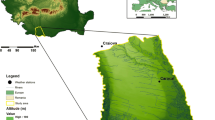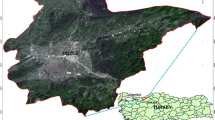Abstract
This study presents a methodology for modeling and mapping the seasonal and annual air temperature and precipitation climate normals over Greece using several topographical and geographical parameters. Data series of air temperature and precipitation from 84 weather stations distributed evenly over Greece are used along with a set of topographical and geographical parameters extracted with Geographic Information System methods from a digital elevation model (DEM). Normalized difference vegetation index (NDVI) obtained from MODIS Aqua satellite data is also used as a geographical parameter. First, the relation of the two climate elements to the topographical and geographical parameters was investigated based on the Pearson’s correlation coefficient to identify the parameters that mostly affect the spatial variability of air temperature and precipitation over Greece. Then a backward stepwise multiple regression was applied to add topographical and geographical parameters as independent variables into a regression equation and develop linear estimation models for both climate parameters. These models are subjected to residual correction using different local interpolation methods, in an attempt to refine the estimated values. The validity of these models is checked through cross-validation error statistics against an independent test subset of station data. The topographical and geographical parameters used as independent variables in the multiple regression models are mostly those found to be strongly correlated with both climatic variables. Models perform best for annual and spring temperatures and effectively for winter and autumn temperatures. Summer temperature spatial variability is rather poorly simulated by the multiple regression model. On the contrary, best performance is obtained for summer and autumn precipitation while the multiple regression model is not able to simulate effectively the spatial distribution of spring precipitation. Results revealed also a relatively weaker model performance for precipitation than that for air temperature probably due to the highly variable nature of precipitation compared to the relatively low spatial variability of air temperature field. The correction of the developed regression models using residuals improved though not significantly the interpolation accuracy.






Similar content being viewed by others
References
Agnew MD, Palutikof JP (2000) GIS-based construction of baseline climatologies for the Mediterranean using terrain variables. Clim Res 14:115–127
Chiles, J.-P. and P. Delfiner (1999) Geostatistics, modeling spatial uncertainty, Wiley Series in Probability and statistics.
Daly C, Helmer EH, Quiñones M (2003) Mapping the climate of Puerto Rico, Vieques, and Culebra. Int J Climatol 23:1359–1381
Draper NR, Smith H (1998) Applied regression analysis. Wiley series in probability and statistics. Wiley, New York
Fan J, Gijbels I (1996) Local polynomial modeling and its applications. Chapman & Hall, London
Fisher, N. I., T. Lewis, and B. J. J. Embleton (1987) Statistical analysis of spherical data, Cambridge University Press, 329 pp.
Goodale CL, Aber JD, Ollinger SV (1998) Mapping monthly precipitation, temperature, and solar radiation for Ireland with polynomial regression and a digital elevation model. Clim Res 35:35–49
Guan H, Wilson JL, Makhnin O (2005) Geostatistical mapping of mountain precipitation incorporating autosearched effects of terrain and climatic characteristics. J Hydrometeorol 6:1018–1031
Hogewind F, Bissolli P (2011) Operational maps of monthly mean temperature for WMO Region VI (Europe and Middle East). Quart J Hungarian Meteorol Service 115(1–2):31–49
Isaaks EH, Srivastava RM (1989) An Introduction to Applied Geostatistics. Oxford University Press, New York, 561 pp
Lam NS (1983) Spatial interpolation methods review. Am Cartographer 10:129–149
Lloyd CD (2005) Assessing the effect of integrating elevation data into the estimation of monthly precipitation in Great Britain. J Hydrol 308:128–150
Markidis MG, Kalivas DP, Kollias VJ (2005) Comparison of interpolation methods for the prediction of reference evapotranspiration—an application in Greece. Water Resour Manag 19:251–278
Miles J, Shevin M (2001) Applying regression & correlation: a guide for students and researchers. SAGE Publication Ltd, London
Naoum S, Tsanis IK (2003) Temporal and spatial variation of annual rainfall on the island of Crete, Greece. Hydrol Process 17:1899–1922
Ninyerola M, Pons X, Roure JM (2000) A methodological approach of climatological modeling of air temperature and precipitation through GIS techniques. Int J Climatol 20:1823–1841
Pardo-Igúzquiza E (1998) Comparison of geostatistical methods for estimating the areal average climatological rainfall mean using data on precipitation and topography. Int J Climatol 18:1031–1047
Schaum (2008) Principles of local polynomial interpolation, 37th IEEE Applied Imagery Pattern Recognition Workshop, 2008, pp.1-6.
Shepard, D. (1968) A two-dimensional interpolation function for irregularly-spaced data, Proc. 23rd National Conference ACM, ACM, 517-52.
World Meteorological Organization (1967) Technical note 84, WMO-208 “A note on climatological normals” Geneva.
World Meteorological Organization (2011) WMO No100 “Guide to meteorological practices” Geneva.
Zhang X, Srinivasan R (2009) GIS-based spatial precipitation estimation: a comparison of geostatistical approaches. J Am Resour Ass 45(4):894–906
Acknowledgments
This research has been co-financed by the European Union (European Regional Development Fund) and Greek national funds through the Operational Program “Competitiveness and Entrepreneurship” of the National Strategic Reference Framework (NSRF)—Research Funding, Program COOPERATION 2009 (no 09COP-31-1094, Title “Development of a Geographic Climate Information System”).
Author information
Authors and Affiliations
Corresponding author
Rights and permissions
About this article
Cite this article
Feidas, H., Karagiannidis, A., Keppas, S. et al. Modeling and mapping temperature and precipitation climate data in Greece using topographical and geographical parameters. Theor Appl Climatol 118, 133–146 (2014). https://doi.org/10.1007/s00704-013-1052-4
Received:
Accepted:
Published:
Issue Date:
DOI: https://doi.org/10.1007/s00704-013-1052-4




